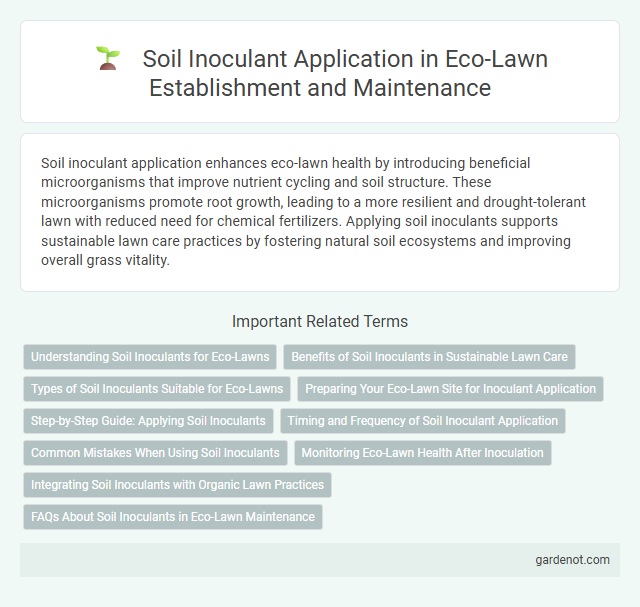Soil inoculant application enhances eco-lawn health by introducing beneficial microorganisms that improve nutrient cycling and soil structure. These microorganisms promote root growth, leading to a more resilient and drought-tolerant lawn with reduced need for chemical fertilizers. Applying soil inoculants supports sustainable lawn care practices by fostering natural soil ecosystems and improving overall grass vitality.
Understanding Soil Inoculants for Eco-Lawns
Soil inoculants for eco-lawns introduce beneficial microbes that enhance nutrient cycling, improve soil structure, and increase plant resilience to environmental stress. These microbial communities foster symbiotic relationships with grass roots, promoting healthier growth and reducing the need for chemical fertilizers. Understanding the specific formulation and microbial strains in inoculants is crucial for optimizing soil health and achieving sustainable, eco-friendly lawn management.
Benefits of Soil Inoculants in Sustainable Lawn Care
Soil inoculants enhance Eco-lawn health by introducing beneficial microorganisms that improve nutrient cycling and boost soil fertility. These microbes promote natural disease resistance and increase drought tolerance, reducing reliance on chemical fertilizers and water. Sustainable lawn care benefits from soil inoculants through improved soil structure and long-term ecosystem balance.
Types of Soil Inoculants Suitable for Eco-Lawns
Mycorrhizal fungi, nitrogen-fixing bacteria, and phosphate-solubilizing bacteria are key soil inoculants suitable for eco-lawns due to their ability to enhance nutrient uptake and improve soil structure. These beneficial microorganisms promote healthier root systems and increase drought resistance, reducing the need for synthetic fertilizers. Selecting inoculants specifically formulated for turfgrass ecosystems ensures optimal growth and sustainability in eco-lawn maintenance.
Preparing Your Eco-Lawn Site for Inoculant Application
Preparing your eco-lawn site for soil inoculant application involves thoroughly aerating the soil to enhance microbial colonization and improve nutrient absorption. Ensure the soil moisture is optimal, neither too dry nor waterlogged, to support inoculant viability and root establishment. Remove existing debris and thatch to facilitate direct contact between the inoculant and the soil, promoting effective microbial activity for sustainable turf health.
Step-by-Step Guide: Applying Soil Inoculants
Applying soil inoculants enhances Eco-lawn health by introducing beneficial microbes that improve nutrient availability and soil structure. Begin by preparing the soil with light aeration to increase inoculant penetration, then evenly distribute the inoculant using a sprayer or spreader, following manufacturer dosage instructions precisely. Water the lawn gently after application to activate the microbes and maintain consistent moisture for optimal colonization and improved Eco-lawn growth.
Timing and Frequency of Soil Inoculant Application
Optimal timing for soil inoculant application in eco-lawns coincides with early spring or fall when soil temperatures range between 50-70degF, promoting microbial activity and root establishment. Frequency depends on soil health and inoculant type, with most recommendations suggesting reapplication every 6-12 months to maintain microbial populations and enhance nutrient cycling. Consistent monitoring of soil conditions helps determine precise intervals, ensuring sustained eco-lawn vitality and reduced chemical dependency.
Common Mistakes When Using Soil Inoculants
Applying soil inoculants without proper soil testing often leads to ineffective microbial colonization and wasted resources. Overusing inoculants or applying them under extreme weather conditions can disrupt the delicate soil microbial balance, reducing their efficacy. Neglecting proper storage and handling of inoculants also decreases microbial viability, compromising the benefits for eco-lawn health and growth.
Monitoring Eco-Lawn Health After Inoculation
Monitoring Eco-Lawn health after soil inoculant application involves regularly assessing microbial activity and soil nutrient levels to ensure effective symbiosis and plant growth. Soil samples and root zone measurements help track beneficial fungi and bacteria populations, which enhance nutrient uptake and disease resistance. Early detection of imbalances allows for timely corrective measures, maintaining optimal Eco-Lawn vitality and sustainability.
Integrating Soil Inoculants with Organic Lawn Practices
Soil inoculants rich in beneficial microbes enhance nutrient cycling and bolster soil structure, essential for sustainable eco-lawns. Integrating these inoculants with organic lawn practices promotes natural pest resistance and supports microbial diversity without synthetic chemicals. This synergy improves soil health, leading to robust lawn growth and increased resilience against environmental stresses.
FAQs About Soil Inoculants in Eco-Lawn Maintenance
Soil inoculants in eco-lawn maintenance introduce beneficial microbes that enhance nutrient cycling, improve soil structure, and suppress pathogens. Common FAQs address application timing, compatibility with fertilizers, and expected results, emphasizing early spring or fall use for optimal root colonization and avoiding chemical interference. Proper soil inoculant use supports sustainable, healthy turf by fostering a resilient microbial ecosystem that reduces reliance on synthetic inputs.
Soil inoculant application Infographic

 gardenot.com
gardenot.com